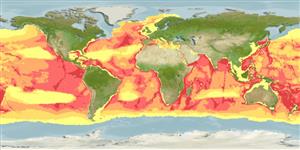Common names from other countries
Environment: milieu / climate zone / depth range / distribution range
Écologie
Pélagique; océanodrome (Ref. 75906); profondeur 0 - 2332 m (Ref. 116169). Tropical; 90°N - 90°S, 180°W - 180°E
Atlantic Ocean, Mediterranean and Indo-Pacific. Tropical to warm temperate.
Length at first maturity / Taille / Poids / Âge
Maturity: Lm ?, range 366 - 427 cm Max length : 600 cm TL mâle / non sexé; (Ref. 1394); 500 cm TL (female); poids max. publié: 2.0 t (Ref. 1394)
Found in shallow inshore (Ref. 122680) and deep offshore waters (Refs. 1394, 118705). Typically in groups of 10 to 60 individuals (Ref. 801). Food sharing is observed in this species, and they travel in a broad band up to several kilometers wide in order to increase success of finding prey (Ref. 122680). Feeds primarily on fish like mahi mahi and yellowfin tuna (Ref. 122680) and cephalopods (Refs. 801, 1394, 118705); was reported to attack small cetaceans and, on one occasion, even a humpback whale (Ref. 1394).
Life cycle and mating behavior
Maturité | Reproduction | Frai | Œufs | Fécondité | Larves
Breeding occurs throughout the year (Ref. 97351).
Tan, J.M.L. 1995. (Ref. 936)
Statut dans la liste rouge de l'IUCN (Ref. 130435)
statut CITES (Ref. 108899)
Not Evaluated
Utilisations par l'homme
Pêcheries: commercial
FAO - pêcheries: landings, species profile | FishSource | Sea Around Us
Outils
Sources Internet
Estimates based on models
Preferred temperature
(Ref.
115969): 2.3 - 5.8, mean 3.4 (based on 3246 cells).
Vulnérabilité
Very high vulnerability (85 of 100).
Catégorie de prix
Unknown.
